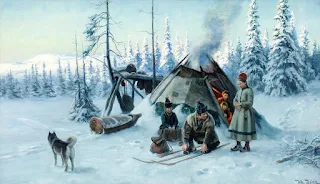 |
| Laplander camp at Gleen with reindeer that had been shot. |
Johan Tiren born 1853 in Sweden, died 1911 in Sweden.
Tiren became deeply involved in the issue of rights for the Sami (Laplanders) and, in 1892, painted a controversial scene showing them with some of their reindeer that had been shot by a farmer. It was inspired by a real incident involving a landowner named William Farup of Ljusnedal who had instigated the slaughtering of reindeer belonging to the Sami so the area could be developed.
 |
| Poor muzzle discipline. He might just be carrying it to hand to his elder who could then put a percussion cap on it. A New York reload. |
 |
| Hunting "elk", what we know as moose on this side of the Atlantic |
 |
| The weapon is presumably to protect the herds from wolves and the predations of greedy neighbors |
The firearms used by nomads were typically whatever they could get their hands on. Military surplus from 40 years ago would be common and the rifling rotted out by black-powder. Consequently, the typical weapon would be a .57ish caliber, smooth-bore which would fire a half-ounce(ish) round-ball in the 1200fps-to-1400fps range.
Not normally what we think of when we talk about rifles suitable for moose. But these guys had all day to track the moose after shooting and the shots were launched from very close range. Woodcraft!
It seems unlikely that many shots were fired at small game. Lead and black-powder were hard to come by. Spending a half-ounce of lead and a tenth-of-an-ounce of black-powder to collect a four-pound hare wasn't a great trade-off when small game could be snared or clubbed and eggs collected by hand.
 |
| Reindeer were used for draft animals as well as milk, meat and hide. |
This style of hut is heated with an open fire and occupants are heated by radiant heat. It is a hog for firewood. No matter, when the deadwood that is close is depleted, the hut is easily moved to another site with abundant wood.
 |
| Based on her costume, this painting might not be from Lapland but from Bavaria where he spent part of 1881 |
Survival on-the-margins required ceaseless industry. No time to look at smart-phones. This young lady is knitting while she watches the family milch cow. She is also wearing a foraging apron in case she sees something worth bringing back home.
In a pre-industrial, agricultural economy, there were long-duration, low-intensity tasks like watching livestock. During that time, other tasks that supported the family economy were fitted in, like mortar between the rocks. It could be picking berries or knitting or spinning or collecting some sticks for the stove.
 |
| After the Blizzard. |
Life-on-the-margin comes at a cost. Population pressure is self-limiting. This family lost one of its sons and some of their reindeer herd. Looking at the young man's skin-tones is eerie. I suspect the artist had seen people who died of exposure.
A question to my readers in Alaska, Scandinavia and the colder parts of Canada: "How long does it take to grow spruce trees the size of the ones shown in Tiren's paintings?"
I expect the estimates to be all over the place. One can see the effects of soil fertility and shorter growing season between Eaton Rapids, Michigan (42.5 Latitude) and Marquette, Michigan (46.6 Latitude). Pine and spruce species that might show 36" of annual growth in their peak years might only show 12"-to-15" in the Upper Peninsula.
My guess is in the +40 year range but it could be anywhere from 20 years to over 80. The thing is, I don't need to guess because I can ask people who live "there".
The point being, if a climate can only produce an above-ground net biomass of 500 pounds a year then one must expend a lot of energy bringing the biomass to your house/animals or you can move to areas that have not been "harvested" in the last few generations.
Your thoughts?


Thanks for doing Tuesday art. I miss Remus.
ReplyDeleteAt 64 degrees North, with adequate rainfall, I would guess White Spruce like those would be 30 or so years old.
ReplyDeleteThank-you, sir.
DeleteAhhh, firewood. I love it so. I even graphed moisture content vs. heat output when I lived in Alaska. That was quite a birch.
ReplyDeletehttps://harvest.usask.ca/handle/10388/ETD-2015-08-2182
ReplyDeleteThis might help. I didn't look at it all but seems to have detail. If l am reading the charts right a half mm might be it but this is near trendline.
Treeline. Screwed by autocorrect again.
ReplyDeletehttps://www.google.com/search?q=black+spruce+growth+curve+figures&oq=black+spruce+growth+curve+figures&aqs=chrome..69i57.28538j0j8&client=tablet-android-bell-ca&sourceid=chrome-mobile&ie=UTF-8
ReplyDeleteUnder good growing conditions it may have reached 2-4 m in height by age 10, and 12 m by age 40 (tree growth rates are highly variable and dependent on many conditions). Black spruce can grow to reach heights up to 20 m and are thought to live as long as 280 years, though few are thought to reach this age, owing to the prevalence of forest fires and logging in the boreal forest.
ReplyDeletehttp://www.naturenorth.com/winter/blspruce/Fblsprce_4.html#:~:text=Under%20good%20growing%20conditions%20it,and%20dependent%20on%20many%20conditions).
ReplyDelete